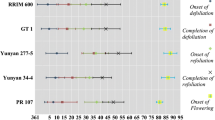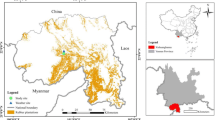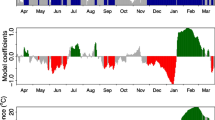Abstract
The phenology of rubber trees (Hevea brasiliensis) could be influenced by meteorological factors and exhibits significant changes under different geoclimates. In the sub-optimal environment in Xishuangbanna, rubber trees undergo lengthy periods of defoliation and refoliation. The timing of refoliation from budburst to leaf aging could be affected by powdery mildew disease (Oidium heveae), which negatively impacts seed and latex production. Rubber trees are most susceptible to powdery mildew disease at the copper and leaf changing stages. Understanding and predicting leaf phenology of rubber trees are helpful to develop effective means of controlling the disease. This research investigated the effect of several meteorological factors on different leaf phenological stages in a sub-optimal environment for rubber cultivation in Jinghong, Yunnan in Southwest China. Partial least square regression was used to quantify the relationship between meteorological factors and recorded rubber phenologies from 2003 to 2011. Minimum temperature in December was found to be the critical factor for the leaf phenology development of rubber trees. Comparing the delayed effects of minimum temperature, the maximum temperature, diurnal temperature range, and sunshine hours were found to advancing leaf phenologies. A comparatively lower minimum temperature in December would facilitate the advancing of leaf phenologies of rubber trees. Higher levels of precipitation in February delayed the light green and the entire process of leaf aging. Delayed leaf phenology was found to be related to severe rubber powdery mildew disease. These results were used to build predictive models that could be applied to early warning systems of rubber powdery mildew disease.






Similar content being viewed by others
References
Ahrends A, Hollingsworth PM, Ziegler AD, Fox JM, Chen H, Su Y, Xu J (2015) Current trends of rubber plantation expansion may threaten biodiversity and livelihoods. Glob Environ Chang 34:48–58. https://doi.org/10.1016/j.gloenvcha.2015.06.002
Borchert R (1998) Responses of tropical trees to rainfall seasonality and its long-term changes. In: Potential impacts of climate change on tropical forest ecosystems. Springer, Berlin, pp 241–253
Bullock SH, Solis-Magallanes JA (1990) Phenology of canopy trees of a tropical deciduous forest in Mexico. Biotropica 22:22–35
Cao M, Zou XM, Warren M, Zhu H (2006) Tropical forests of Xishuangbanna, China. Biotropica 38:306–309. https://doi.org/10.1111/j.1744-7429.2006.00146.x
Eamus D, Prior L (2001) Ecophysiology of trees of seasonally dry tropics: comparisons among phenologies. Adv Ecol Res 32:113–197
Fu YH, Piao S, Vitasse Y et al (2015) Increased heat requirement for leaf flushing in temperate woody species over 1980–2012: effects of chilling, precipitation and insolation. Glob Chang Biol 21:2687–2697. https://doi.org/10.1111/gcb.12863
Guo L, Dai J, Ranjitkar S, Xu J, Luedeling E (2013) Response of chestnut phenology in China to climate variation and change. Agric For Meteorol 180:164–172. https://doi.org/10.1016/j.agrformet.2013.06.004
Huang Z, Pan Y (1992a) Rubber cultivation under climatic stresses in China. In: Natural rubber: biology, cultivation and technology, Developments in Crop Science Amsterdam, Elsevier 220 C239
Huang Z, Pan Y (1992b) Rubber cultivation under climatic stresses in China. In: Natural rubber: biology, cultivation and Technology. pp 220–238
Jia K (2006) Study on growth change of the rubber plantation along an altitudinal gradient in Xishuangbanna, Southwest China. Master thesis, Graduate University of Chinese Academy of Sciences (Xishuangbanna Tropical Botanical Garden)
Li YW, Lan GY, Xia YJ (2016) Rubber trees demonstrate a clear retranslocation under seasonal drought and cold stresses. Front Plant Sci 7:11. https://doi.org/10.3389/fpls.2016.01907
Liang S, Chen B (1985) The whorl phenology changing pattern of rubber trees in Gaozhou. Chin J Trop Crop Res 19–25
Lieberman D (1982) Seasonality and phenology in a dry tropical forest in Ghana. J Ecol 70:791–806. https://doi.org/10.2307/2260105
Liu WJ, Li JT, HJ L, Wang PY, Luo QP, Liu WY, Li HM (2014) Vertical patterns of soil water acquisition by non-native rubber trees (Hevea brasiliensis) in Xishuangbanna, southwest China. Ecohydrology 7:1234–1244. https://doi.org/10.1002/eco.1456
Luedeling E, Gassner A (2012) Partial least squares regression for analyzing walnut phenology in California. Agric For Meteorol 158–159:43–52. https://doi.org/10.1016/j.agrformet.2011.10.020
Nanda A, Suresh HS, Krishnamurthy YL (2014) Phenology of a tropical dry deciduous forest of Bhadra wildlife sanctuary, southern India. Ecol Process 3:1–12
Piao S, Tan J, Chen A et al. (2015) Leaf onset in the northern hemisphere triggered by daytime temperature 6:6911 https://doi.org/10.1038/ncomms7911
Plant Protection Research Institute of South China Academy of Tropical Crops Sciences (1983) Epidemic pattern of rubber powdery mildew in 1959-1981. Chin J Trop Crops 4:75–84
Priyadarshan P (2011) Biology of Hevea rubber. CABI, Wallingford
Qiu J (2010) China drought highlights future climate threats. Nature 465:142
Ranjitkar S, Luedeling E, Shrestha KK, Guan KY, JC X (2013) Flowering phenology of tree rhododendron along an elevation gradient in two sites in the Eastern Himalayas. Int J Biometeorol 57:225–240. https://doi.org/10.1007/s00484-012-0548-4
Reich PB (1995) Phenology of tropical forests: patterns, causes, and consequences. Can J Bot 73:164–174
Richardson AD, Anderson RS, Arain MA et al (2012) Terrestrial biosphere models need better representation of vegetation phenology: results from the North American Carbon Program Site Synthesis. Glob Chang Biol 18:566–584. https://doi.org/10.1111/j.1365-2486.2011.02562.x
Shao Z, Hu Z (1984) Powdery mildew infestation investigation on different leaf phenologies of rubber trees Yunnan. Trop Technol 1–5
Shao Z, Zhou J, Chen J, Li C, Meng Y (1996) Powdery mildew epidemic rate of rubber trees Yunnan. Trop Technol 2–12
Shen M, Piao S, Chen X et al (2016) Strong impacts of daily minimum temperature on the green-up date and summer greenness of the Tibetan Plateau. Glob Chang Biol 22:3057–3066. https://doi.org/10.1111/gcb.13301
Strahler A, Strahler A (2007) Physical geography. John Wiley & Sons, Hoboken
Tan Z, Zhang Y, Song Q, Yu G, Liang N (2014) Leaf shedding as an adaptive strategy for water deficit: a case study in Xishuangbanna’s rainforest. J Yunnan Univ Nat Sci 36:273–280
Tu M, Cai H, Hua Y, Sun A, Huang H (2012) In vitro culture method of powdery mildew (Oidium heveae Steinmann) of Hevea brasiliensis. Afr J Biotechnol 11:13167–13172
Wang L (1996) The climatic fundamental of high yield rubber production in Yunnan. Trop Technol 25–32
Xiao C (2010) Comparative studies of comprehensive prevention and control for rubber powdery mildew China. Trop Agric 56–58
Yu H, Luedeling E, Xu J (2010) Winter and spring warming result in delayed spring phenology on the Tibetan Plateau. Proc Natl Acad Sci U S A 107:22151–22156. https://doi.org/10.1073/pnas.1012490107
Yu H, Hammond J, Ling S, Zhou S, Mortimer PE, Xu J (2014) Greater diurnal temperature difference, an overlooked but important climatic driver of rubber yield. Ind Crop Prod 62:14–21. https://doi.org/10.1016/j.indcrop.2014.08.001
Yunnan Institute of Tropical Crops (1981) Rubber powdery mildew forecasting in Jinghong Yunnan. Trop Technol 28–34
Zhang J, Cao M (1995) Tropical forest vegetation of Xishuangbanna, SW China and its secondary changes, with special reference to some problems in local nature conservation. Biol Conserv 73:229–238. https://doi.org/10.1016/0006-3207(94)00118-a
Zhu H, Cao M, HB H (2006) Geological history, flora, and vegetation of Xishuangbanna, southern Yunnan, China. Biotropica 38:310–317. https://doi.org/10.1111/j.1744-7429.2006.00147.x
Acknowledgements
This work was additionally supported by a scholarship grant by Kunming Institute of Botany to Deli Zhai. The authors would like to thank Li Guoyao, Wang Quanbao, and Li Yuying in Jinghong Farm for providing rubber data for analysis.
Funding
This work was funded by the Frontier Key Science Project of Chinese Academy of Sciences (QYZDY-SSW-SMC014), the National Natural Science Foundation of China (Grant 31300403), and the China Postdoctoral Science Foundation (Grant 2013M540722).
Author information
Authors and Affiliations
Corresponding author
Rights and permissions
About this article
Cite this article
Zhai, DL., Yu, H., Chen, SC. et al. Responses of rubber leaf phenology to climatic variations in Southwest China. Int J Biometeorol 63, 607–616 (2019). https://doi.org/10.1007/s00484-017-1448-4
Received:
Revised:
Accepted:
Published:
Issue Date:
DOI: https://doi.org/10.1007/s00484-017-1448-4




